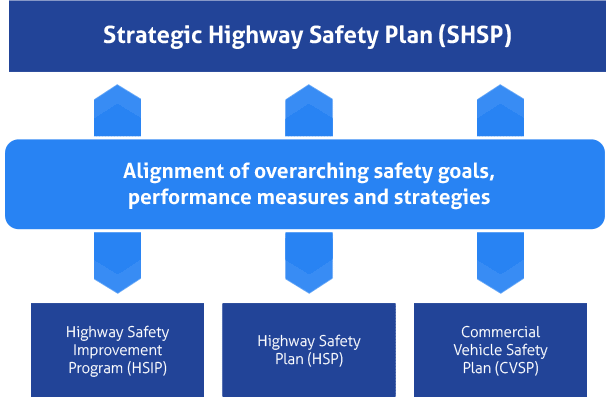Why EMS Should Participate in the SHSP Process
The SHSP is developed specifically to reduce deaths on public roads, an effort in which EMS plays a significant role. EMS brings a unique and valuable perspective to the SHSP, which is why it is considered the fourth "E" of the traditional three "E"s of highway safety.
In this section, learn more about:- What is a Strategic Highway Safety Plan (SHSP)?
- Benefits of an SHSP
- How is the SHSP relevant to EMS Officials?
- EMS-Related Highway Safety Plans
- Other Resources for SHSP Development, Implementation, and Evaluation
How EMS and Highway Safety Can Work Together
Learn more about important Highway Safety Programs and Plans
What is a Strategic Highway Safety Plan (SHSP)?
A Strategic Highway Safety Plan is a state's comprehensive transportation safety plan. The primary goal of an SHSP is to reduce fatalities and serious injuries on all public roads. It is a data-driven, multidisciplinary plan that establishes statewide performance measures, goals, objectives, and emphasis areas and describes a program of strategies to reduce or eliminate safety hazards. Legislation requires that all States have an SHSP that is approved by the governor of each state or the responsible state agency.
The SHSP is developed by the state Department of Transportation (DOT) in consultation with federal, state, local, and tribal safety stakeholders. The collaborative process of developing and implementing an SHSP brings together and draws on the strengths and resources of all safety partners. The SHSP is considered the state's "umbrella" highway safety plan and is intended to help safety partners better leverage limited resources and work together to achieve common safety goals.

Learn more about other EMS-related Safety Plans, the HSIP & HSP
The Benefits of an SHSP
- Establishes common statewide goals and priorities
- Strengthens existing partnerships
- Builds new safety coalitions
- Promotes data, knowledge, and resource-sharing
- Avoids redundant activities
- Leverages existing resources, such as funding, personnel, and leadership
- Directs safety resources and investment decisions
- Incorporates both behavioral and infrastructure strategies and countermeasures to more effectively reduce highway fatalities and serious injuries
What does current legislation say about including EMS in the SHSP process?
Current legislation requires that a state's SHSP address a variety of factors when determining strategies for the SHSP emphasis areas. Highway safety is a diverse and complex field, and motor vehicle crashes generally involve multiple contributing factors. To ensure that the emphasis areas in the SHSP focus on issues with the greatest potential to reduce fatalities and serious injuries, states are required to implement and update the SHSP in collaboration with a range of partners, including the 4 Es of highway safety: engineering, enforcement, education, and emergency medical services (EMS). Each state should identify emphasis areas based on the analysis of available safety data and input from all stakeholders. Emphasis areas may change during SHSP updates based on the results of ongoing safety data analysis.
How is the SHSP relevant to EMS Officials?
Coordinating the state's SHSP safety goals and strategies with other statewide plans and programs advances EMS's safety agenda as well. That's because these programs and plans reflect statewide priorities, provide a blueprint for action for key agencies, and influence how resources are distributed. EMS-related improvements could potentially receive funding through the SHSP process or other resources if they are deemed a priority based on available data. State Highway Safety Offices (SHSOs) administer a variety of grant programs that are authorized and funded through federal legislation, some of which may be used for EMS service improvements. Learn more about potential funding available to EMS through the SHSP.
The Haddon Matrix: The Intersection of Highway Safety and EMS
The Haddon Matrix is a familiar tool for understanding and addressing factors for injury prevention. Developed by William Haddon, the first director of the National Highway Traffic Safety Administration (NHTSA), the matrix is most appropriately viewed in terms of fatality prevention in the context of highway safety.
While EMS can and does play a role in primary injury prevention in many communities, its central involvement is post-crash, when the response time, proximity to a trauma center, and the skills and equipment of the responders are all factors in providing the best possible care, or even, the prevention of a fatality
More on the Haddon MatrixOther Resources for SHSP Development, Implementation, and Evaluation
Strategic Highway Safety Plans: A Champion's Guidebook to Saving Lives, Second Edition, FHWA, Office of Safety
MAP21 Interim Guidance for SHSP development
Strategic Highway Safety Plan Implementation Process Model, FHWA, Office of Safety
Traffic Safety Performance Measures for States and Federal Agencies
A Primer on Safety Performance Measures for the Transportation Planning Process
Strategic Highway Safety Plan, American Association of State Highway and Transportation Officials
Guidance for the Implementation of the AASHTO Strategic Highway Safety Plans – 23 Topic Area Volumes, Transportation Research Board, NCHRP Report 500, Volume 1 through 23
Crash Modification Factors (CMF) Clearinghouse, FHWA
Countermeasures that Work: A Highway Safety Countermeasure Guide for State Highway Safety Offices, Sixth Edition, NHTSA
Proven Safety Countermeasures, FHWA, Office of Safety
Strategic Highway Safety Plan Evaluation Process Model (EPM), FHWA, Office of Safety
The Art of Appropriate Evaluation-A Guide for Highway Safety Program Managers, NHTSA
HSIP Noteworthy Practice Series, FHWA, Office of Safety
"Leadership that Saves Lives" (A DOT flyer on how leaders can influence safety initiatives, programs, and projects in the SHSP)
"Get Involved" (a DOT flyer for stakeholders from the 4 Es of highway safety on getting involved in the SHSP process)